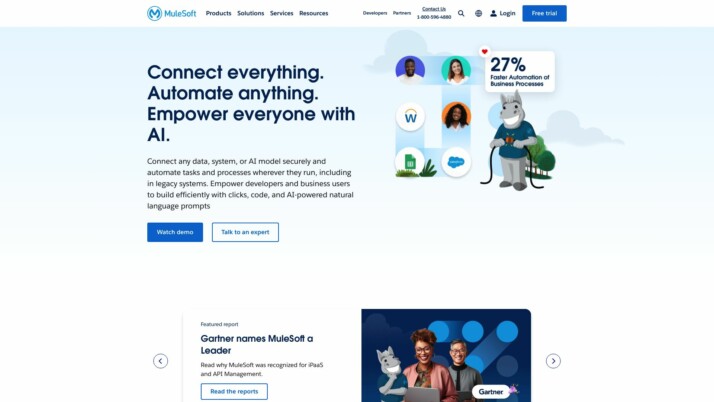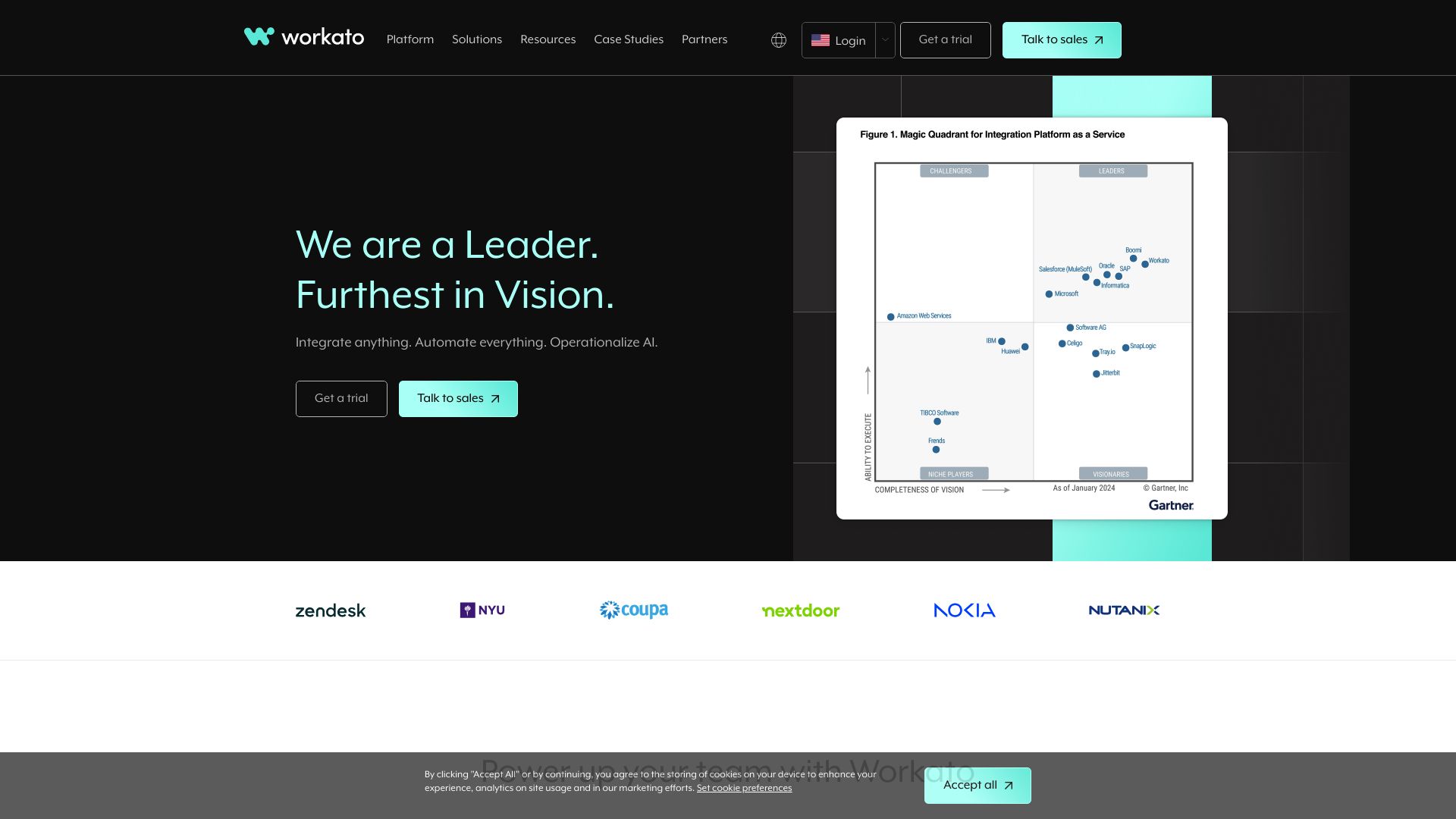Mulesoft vs. Workato: AI-Powered Integration Platforms Compared
AI platforms are transforming business operations across industries, offering powerful tools for automation, integration, and enhanced decision-making. This review compares three leading solutions: Mulesoft vs. Workato, and SmythOS. We’ll explore their core features, AI capabilities, and suitability for different business needs.
Whether you’re a developer seeking robust API management, a business leader looking for enterprise-grade automation, or a non-technical user in search of accessible AI tools, this comparison will help you navigate the landscape of AI-powered platforms. By examining each solution’s strengths and limitations, we aim to provide insights that will guide your choice in leveraging AI to drive innovation and efficiency in your organization.
Mulesoft Overview
Mulesoft revolutionizes enterprise connectivity with its comprehensive integration platform. The Anypoint Platform empowers organizations to design, build, and manage APIs effortlessly, bridging the gap between disparate systems and data sources. This powerful tool enables businesses to create seamless digital experiences, automate processes, and leverage AI capabilities across their operations.


At the core of Mulesoft’s offering is API-led connectivity, a strategic approach that promotes reusability and security in digital solutions. The platform’s integration with Einstein AI enhances developer productivity, allowing rapid project initiation through natural language prompts. This AI-driven capability, combined with the visual development environment of Anypoint Studio, significantly accelerates the creation and deployment of APIs and integrations.
Mulesoft revolutionizes enterprise connectivity with its comprehensive integration platform. The Anypoint Platform empowers organizations to design, build, and manage APIs effortlessly…
Mulesoft’s commitment to robust security and governance is evident in its Anypoint Flex Gateway and API Governance features. These tools ensure that API management remains secure and controlled, a critical factor for organizations dealing with sensitive data and AI integrations. The platform’s ability to support various deployment options, including CloudHub, on-premises runtimes, and Kubernetes-based solutions, provides the flexibility needed in today’s diverse IT landscapes.
While Mulesoft offers a powerful suite of tools, its complexity may present a learning curve for some users. The platform’s extensive features and enterprise-focused approach might be overwhelming for smaller organizations or those new to API management. Additionally, pricing can be a consideration for budget-conscious businesses, as Mulesoft’s enterprise-grade solutions often come with corresponding costs.
Mulesoft’s vision extends beyond simple integration, aiming to empower organizations with AI-driven, real-time decision-making capabilities. By connecting everything, automating anything, and infusing AI across business functions, Mulesoft positions itself as a key player in driving digital transformation. This forward-thinking approach, coupled with its robust feature set, makes Mulesoft a compelling choice for enterprises seeking to harness the full potential of their data and systems in an increasingly AI-driven world.
Workato Overview
Workato streamlines enterprise automation with its robust, AI-powered platform. This innovative solution empowers businesses to create sophisticated workflows and integrations without extensive coding expertise.


Workato’s AI by Workato, developed in collaboration with OpenAI, enhances the platform’s capabilities. Users can leverage AI models for tasks like text analysis, categorization, and translation without compromising data privacy. The platform’s low-code/no-code interface makes it accessible to business users while still offering the depth required for complex enterprise-level automations.
Workato streamlines enterprise automation with its robust, AI-powered platform. This innovative solution empowers businesses to create sophisticated workflows and integrations without extensive coding expertise.
The platform excels in comprehensive workflow automation, combining data storage, user interface, and business logic. Workato’s pre-built solutions, such as the Knowledge Workbot Accelerator, facilitate rapid deployment of AI-powered tools within existing enterprise applications. The marketplace, boasting over 1,500 connectors and community recipes, fosters a collaborative environment for customization and innovation.
While Workato offers powerful features, users should be aware of certain limitations. The AI capabilities are subject to rate limits, potentially constraining high-volume use cases. The platform’s enterprise focus, while beneficial for large organizations, may present a cost barrier for smaller businesses or those with limited budgets. Additionally, the initial setup and configuration process can be complex for users unfamiliar with automation tools, despite the low-code interface.
Workato’s vision centers on democratizing automation and integration, making these technologies accessible across various business sizes and industries. By leveraging AI capabilities, the platform aims to streamline business processes, enhance productivity, and enable users to create sophisticated automations without extensive technical skills. This approach positions Workato as a significant player in the evolving landscape of enterprise automation and AI integration.
Feature Comparison
Mulesoft and Workato offer robust integration and automation platforms with distinct approaches to AI capabilities. Mulesoft provides extensive API-led connectivity and management tools, while Workato emphasizes low-code/no-code automation with AI enhancements.
In core components, Mulesoft’s Anypoint Platform excels at full-lifecycle API management, offering robust design, development, and monitoring capabilities. Workato, on the other hand, focuses on workflow automation with its intuitive visual interface and pre-built connectors. Mulesoft’s Einstein AI integration enhances developer productivity through natural language prompts, whereas Workato’s AI by Workato, developed with OpenAI, enables AI model integration without compromising data privacy.
Security features highlight significant differences. Mulesoft’s Anypoint Flex Gateway and API Governance ensure secure, controlled API management crucial for sensitive data and AI integrations. Workato, while offering enterprise-grade security, lacks the granular permission settings for AI features that Mulesoft provides, potentially limiting access control in collaborative environments.
Feature Comparison Table
| Mulesoft | Workato | SmythOS | |
|---|---|---|---|
| CORE FEATURES | |||
| Memory & Context | ❌ | ✅ | ✅ |
| Autonomous Agents | ✅ | ❌ | ✅ |
| Explainability & Transparency | ❌ | ✅ | ✅ |
| Multimodal | ✅ | ❌ | ✅ |
| Problem-Solving Capabilities | ❌ | ✅ | ✅ |
| Multi-Agent Collaboration | ✅ | ❌ | ✅ |
| Human-AI Interaction | ❌ | ✅ | ✅ |
| Audit Logs for Analytics | ❌ | ✅ | ✅ |
| SECURITY | |||
| Constrained Alignment | ✅ | ❌ | ✅ |
| Data Encryption | ❌ | ✅ | ✅ |
| COMPONENTS | |||
| Huggingface AIs | ❌ | ❌ | ✅ |
| Zapier APIs | ❌ | ❌ | ✅ |
| All other APIs, RPA | ❌ | ✅ | ✅ |
| Logic | ❌ | ✅ | ✅ |
| Data Lakes | ✅ | ❌ | ✅ |
| DEPLOYMENT OPTIONS (EMBODIMENTS) | |||
| Deploy as Scheduled Agent | ❌ | ✅ | ✅ |
| Scalability | ❌ | ✅ | ✅ |
| DATA LAKE SUPPORT | |||
| Hosted Vector Database | ✅ | ❌ | ✅ |
| Sitemap Crawler | ❌ | ❌ | ✅ |
| YouTube Transcript Crawler | ❌ | ❌ | ✅ |
| URL Crawler | ❌ | ❌ | ✅ |
| PDF Support | ❌ | ✅ | ✅ |
Best Alternative to Mulesoft and Workato
SmythOS stands out as our superior alternative to Mulesoft and Workato, offering a comprehensive AI automation platform that combines ease of use with an extensive feature set. We’ve designed SmythOS to address the limitations of traditional integration platforms while providing unparalleled flexibility for a wide range of use cases.
Our drag-and-drop interface simplifies the creation of complex AI workflows, making advanced automation accessible to users of all skill levels. Unlike Mulesoft’s steep learning curve or Workato’s limited AI capabilities, SmythOS empowers users to build sophisticated AI agents without extensive coding knowledge.
SmythOS empowers users to build sophisticated AI agents without extensive coding knowledge.
We’ve packed SmythOS with features that outshine the competition. Our platform supports autonomous agents, multi-agent collaboration, and human-AI interaction – capabilities not fully realized in either Mulesoft or Workato. SmythOS also offers robust memory and context management, ensuring your AI agents maintain coherent, context-aware interactions across various applications.
Security and scalability are at the forefront of SmythOS’s design. We provide enterprise-grade data encryption and constrained alignment features, addressing the security gaps present in Workato’s AI implementations. Our platform scales effortlessly to meet growing demands, a critical advantage over Mulesoft’s more rigid architecture.
With SmythOS, we’ve eliminated the limitations that hold back Mulesoft and Workato users. Our platform supports a wide array of deployment options, from APIs and webhooks to scheduled agents and chatbots. This versatility, combined with our extensive integration ecosystem, allows businesses to seamlessly incorporate AI into their existing workflows, driving innovation and efficiency across the board.
Conclusion
Mulesoft and Workato offer powerful integration and automation solutions, each with unique strengths. Mulesoft excels in API-led connectivity and enterprise-grade security, making it ideal for large organizations with complex integration needs. Workato shines with its low-code/no-code platform and AI-powered automation, appealing to businesses seeking user-friendly solutions for workflow optimization.
However, SmythOS emerges as the superior choice, combining the best of both worlds with unparalleled flexibility and ease of use. Our platform’s drag-and-drop interface and extensive integration ecosystem democratize AI development, allowing users to create sophisticated workflows without deep technical expertise. SmythOS’s support for multi-agent systems and versatile deployment options, including as APIs, chatbots, or scheduled agents, provides unmatched adaptability for diverse business needs.
Unlike Mulesoft’s steep learning curve or Workato’s potential scalability limitations, SmythOS offers a perfect balance of power and accessibility. Our platform’s ability to integrate with over 300,000 tools and services, coupled with pre-built templates and AI model support, enables rapid development and deployment of AI solutions across any environment.
Experience the future of AI-powered automation with SmythOS. Create a free account today and discover how our platform can revolutionize your workflow, boost productivity, and drive innovation in your organization. With our 30-day money-back guarantee and unlimited agent creation, there’s never been a better time to unleash the power of AI for your business.
Last updated:
Disclaimer: The information presented in this article is for general informational purposes only and is provided as is. While we strive to keep the content up-to-date and accurate, we make no representations or warranties of any kind, express or implied, about the completeness, accuracy, reliability, suitability, or availability of the information contained in this article.
Any reliance you place on such information is strictly at your own risk. We reserve the right to make additions, deletions, or modifications to the contents of this article at any time without prior notice.
In no event will we be liable for any loss or damage including without limitation, indirect or consequential loss or damage, or any loss or damage whatsoever arising from loss of data, profits, or any other loss not specified herein arising out of, or in connection with, the use of this article.
Despite our best efforts, this article may contain oversights, errors, or omissions. If you notice any inaccuracies or have concerns about the content, please report them through our content feedback form. Your input helps us maintain the quality and reliability of our information.
